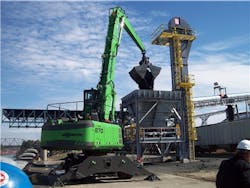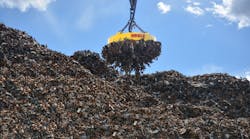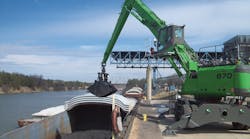Kinder Morgan is one of the largest pipeline transportation and energy storage companies in North America with more than 37,000 miles of pipelines and 170 terminals. The company transports, stores and handles energy products including natural gas, refined petroleum products, crude oil, ethanol, coal and carbon dioxide. It is continuously investing to expand its existing infrastructure and equipment fleet to help meet demands from shippers.
Its Amory terminal sits on 24 acres of land and has a storage capacity of 65,000 metric tons in seven domed buildings. It operates one continuous dock where it handles commodities such as bulk ores, petcoke, steel, lumber and rock coming from cargo barges in the Tenn-Tom Waterway, a 234-mile artificial waterway that provides a connecting link between the Tennessee and Tombigbee Rivers.
A purpose-built machine
Terminal manager Jim Strawn says that the hydraulic elevating cab on the 870 M gives his crew the ability to see as they reach into the barges; but more importantly, it has a purpose-built undercarriage with rubber tires.
“Mobility is the key for us and since this unit is on rubber tires, we can move it a lot easier," Strawn says. "This was a major factor in our decision to get this machine.” Special outrigger pads reduce the ground pressure of the machine and protect the dock surface.
Kinder Morgan purchased the 870 M from Power Equipment Co. The machine has a 6-yard clamshell bucket and a generator package.
“In the future, we are looking at doing a few more things with it like attach a magnet and grapple to give us a little more versatility,” says Strawn, adding that the company is also looking to expand the terminal to handle scrap. “There are several different markets out there we hope to get into, and this machine gives us the option of doing that.” The 870 M is primarily used for unloading coal but it can be outfitted with another clamshell if the terminal gets a rock contract.
Gary Hirsch, Power Equipment's general manager of crane and material handling equipment, says the company has built its business on providing creative and flexible solutions to meet the unique needs of its clients and it is pleased to be Amory’s one-stop shop for all of their equipment requirements.
Flexible solutions
Prior to settling on the Sennebogen model, Strawn says that he looked at other machines.
"We visited the steel mills here and other terminals up the river from us like the Hickman Terminal, that run Sennebogen machines," he says. "They liked them, and I know the steel mills were keen on them. We talked to the folks at Power Equipment who showed us the lifting charts on them, and they gave us outstanding service. That was one of the things that drove the decision: the service we get from them.”
Not having a service contract is not a huge concern for Strawn and his technicians, pointing out that they have not had any downtime with the 870 M since they purchased it in October 2008. Since then it has logged about 800 hours without any problems. “From a serviceability standpoint, it can’t get any simpler,” he says.
The 870 M’s hydraulic system does not rely on computers. It can be subjected to extreme variations in weather and the elements that make sensitive electronics on other machines more prone to failure in the field. Electronics are not something that a technician can fix on the spot. These purpose-built machines utilize smart and simple engineering without relying on complex electronic instruments to ensure the machine starts up and works all the time. After one year in operation, Strawn has noticed that it is also fuel efficient. According to Sennebogen, the material handler uses half of the fuel of a converted excavator.
An elevated vantage pointAlthough simple to maintain, it is the performance that counts. Strawn says he was pleasantly surprised when they started to put the 870 M through its paces.
“I was looking for a machine that can offload a barge in six to six and a half hours," he says. "So far, if the conveyors are working alright, the Sennebogen unit can unload a 35 x 200-foot standard-size river barge in about four and half to five hours, just using the bucket and conveyor.”
In addition to the time benefit, Strawn appreciates the visibility due to the machine’s hydraulic elevating cab system which gives the operator a better top down view to see inside the barge.
“From an operator standpoint, the guys love that machine because it’s stable and once they get set up they can see in the barge without having to strain themselves,” says Strawn. “When it’s up about 22 feet in the air, from that vantage point, the operator can almost see right into the corners. Most of the time they have it raised up about three-quarters of its extended cab position. That way the operator is further out and it is a lot easier for them. With the visibility we get from this machine and the rotating clamshell, we can clean the barge floor pretty good before running a skidsteer in there at the end for the final cleanup.”
Source: Sennebogen



